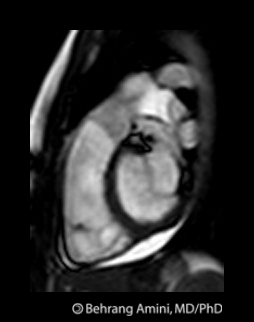 Arrhythmogenic right ventricular dysplasia (ARVD) refers to the fibrofatty infiltration of the right ventricular myocardium, leading to focal or global right ventricular motion abnormalities or focal aneurysms. The distribution of the fibrofatty infiltration is patchy, making biopsy unreliable for diagnosis.
Arrhythmogenic right ventricular dysplasia (ARVD) refers to the fibrofatty infiltration of the right ventricular myocardium, leading to focal or global right ventricular motion abnormalities or focal aneurysms. The distribution of the fibrofatty infiltration is patchy, making biopsy unreliable for diagnosis.
MRI may show transmural fatty infiltration of the right ventricular myocardium, which is neither specific or sensitive. Delayed post-contrast images may show enhancement of the fibrosis. Cine images may show right ventricular wall motion abnormalities (most sensitive), thinning of the myocardium, and right ventricular dilatation.
Diagnosis relies on satisfying major and minor criteria
- 2 major criteria,
- 1 major and 2 minor criteria, or
- 4 minor criteria
- Autopsy or surgically proven disease in a family member
- Fibrofatty replacement of the right ventricular myocardium in the patient
- Right ventricular aneurysm (arrow in image, most specific)
- Severe segmental or global right ventricular dilatation
- Epsilon waves on ECG
- Suspected family history of ARVD or family history of sudden cardiac death
- ECG abnormalities in the right precordial leads (V1-V3)
- Mild segmental or global right ventricular wall motion abnormality
- Antiarrhythmic agents: First choice.
- Catheter ablation: Alternative in patients refractory to antiarrhythmic agents and with localized disease. Also improves the effectiveness of antiarrhythmic agents.
- Implantable cardioverter defibrillator: For patients intolerant of antiarrhythmic agents and at serious risk for sudden death.
- Surgery: Last resort. Initially ventriculotomy, followed by total disconnection of the right ventricular free wall. Cardiac transplantation in special cases.
Reference
- Abbara S and Miller SW. Chapter 9: Pericardial and Myocardial Disease. in Cardiac Imaging: The Requisites (third ed). pp 290-291.
- Kayser HW, van der Wall EE, Sivananthan MU, Plein S, Bloomer TN, de Roos A. Diagnosis of arrhythmogenic right ventricular dysplasia: a review. Radiographics. 2002 May-Jun;22(3):639-48.
No comments:
Post a Comment
Note: Only a member of this blog may post a comment.